|
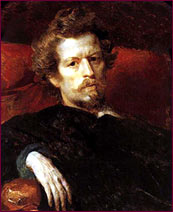 Karl
Brullov Karl
Brullov
The story of Karl Brullov (1799-1852 ) cannot be told
without "The Last Day of Pompeii" and the story
of Russian fine art cannot be told without Brullov. Not only
was he the first Russian painter of world renown, he was also
Russia’s first Romantic artist introducing Western art
and Romanticism to Russia.
He greatly influenced the painting of the 1840s and
1850s, particularly the artists Ge, Aivazovskii, Fedotov,
and Repin.
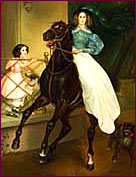 Karl
Brullov was born in 1799 in St. Petersburg into the family
of painters: his great grand-father, his grand-father, his
father and his two elder brothers Fedor and Alexander were
artists. In 1809-1821, Karl studied art in the Academy of
Arts in St. Petersburg. Karl
Brullov was born in 1799 in St. Petersburg into the family
of painters: his great grand-father, his grand-father, his
father and his two elder brothers Fedor and Alexander were
artists. In 1809-1821, Karl studied art in the Academy of
Arts in St. Petersburg.
He displayed such enormous talent that everyone expected him
to surpass his teachers by graduation, which he did.
Briullov graduated from the Academy with honors and was
sent along with his brother Alexander to Italy to study art
as pensioners of the Society for the Promotion of artists.
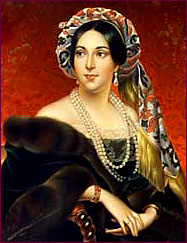 He
spent in Italy 13 years, studying art of the ancient Italy,
copying the antiques in the museums and making a lot of drawings
in the streets of Rome. He painted portraits, both ceremonial
and intimate ones, and created series of genre scenes of everyday
Roman life. The most important of his genre works was "Italian
Midday". He
spent in Italy 13 years, studying art of the ancient Italy,
copying the antiques in the museums and making a lot of drawings
in the streets of Rome. He painted portraits, both ceremonial
and intimate ones, and created series of genre scenes of everyday
Roman life. The most important of his genre works was "Italian
Midday".
In Italy Brullov created over 120 portraits in various
techniques. Among them are portraits of the Russian aristocracy,
residing in Italy - "Prince G. Gagarin", "Countess
Y. Samoilova and her foster children", "Princess
Z. Volkonskaya" etc.
|
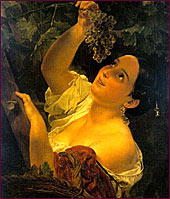 One
of the requirements of the Society for the Promotion of artists
for its pensioners was to paint a big historical picture. In
1827, Brullov visited the excavation site of Pompeii, a town
destroyed and buried in hot lava during an eruption of Volcano
Vesuvius on August 24, 79 A.D. Brullov was deeply impressed
when he saw the town, preserved under the layer of lava, where
a life was suddenly stopped. One
of the requirements of the Society for the Promotion of artists
for its pensioners was to paint a big historical picture. In
1827, Brullov visited the excavation site of Pompeii, a town
destroyed and buried in hot lava during an eruption of Volcano
Vesuvius on August 24, 79 A.D. Brullov was deeply impressed
when he saw the town, preserved under the layer of lava, where
a life was suddenly stopped.
Six years were to pass between the first conception and its
materialization.
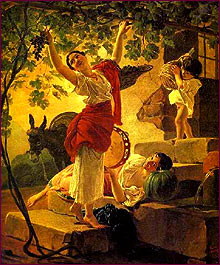 In
1833, Karl Brullov painted the finishing touches on his monumental
"The Last Day of Pompeii" and opened his studio door
for the world to see. In
1833, Karl Brullov painted the finishing touches on his monumental
"The Last Day of Pompeii" and opened his studio door
for the world to see.
The large, complex painting was populated by twenty-seven
human figures, each of them expressing an emotion on his or
her face - alarm, fright, agony, resignation, or the quiet repose
of death - as the destruction rained down upon them from the
exploding Mount Vesuvius.
The reaction in Italy was one of astonishment and acclaim.
Painting was also exhibited in Louvre, Paris. His fame became
so great that the academies of art in the city-states of Florence,
Milan, and Bologna elected him a membership, the jury at the
Paris Art Salon awarded the painting a gold medal, and Tsar
Nicholas I summoned him home to do a painting for him.
|
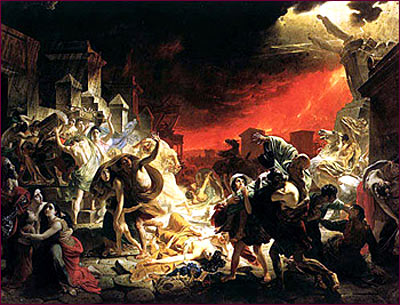
Karl Brullov. The Last Day of Pompeii.
1830-1833. Oil on canvas. The Russian Museum, St-Petersburg,
Russia.
|
|
The "Last Day of Pompeii" established Brullov’s
reputation, but his greatest legacy is found in his portraiture.
In both Italy and Russia, the rich and famous pleaded to sit
for him. In his portraits, Brullov succeeded in capturing
the heart and spirit of those he painted.
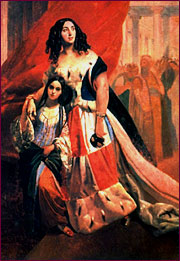 In
1849, Brullov had to come to Italy again for his deteriorating
health, which was due to his unhappy marriage and his hard
work on the paintings of St. Isaac's Cathedral in St. Petersburg,
which he was unable to finish. He spent one year on Madeira,
the climate of each was believed to be beneficial for the
patients with heart diseases, and his last two years in Rome.
He created several excellent works during these years, including
portraits of members of Tittoni family, with whom he was very
close. He died in Rome on June 23, 1852. In
1849, Brullov had to come to Italy again for his deteriorating
health, which was due to his unhappy marriage and his hard
work on the paintings of St. Isaac's Cathedral in St. Petersburg,
which he was unable to finish. He spent one year on Madeira,
the climate of each was believed to be beneficial for the
patients with heart diseases, and his last two years in Rome.
He created several excellent works during these years, including
portraits of members of Tittoni family, with whom he was very
close. He died in Rome on June 23, 1852.

|
|
|
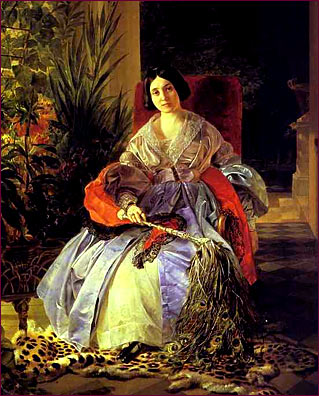
Karl Brullov, Portrait of Princess
Y. Saltykova. 1841. Oil on canvas. The Russian Museum, St-Petersburg.
|

|
|
Ivan Aivazovsky
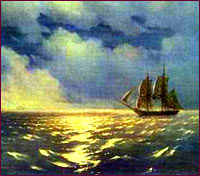 Ivan
Aivazovsky (1817-1900) was born in the family of a merchant
of Armenian origin in the town of Feodosia, Crimea. His parents
were under strained circumstances and he spent his childhood
in poverty. With the help of people who had noticed the talented
youth, he entered the Simpheropol gymnasium, and then the
St. Petersburg Academy of Arts,
where he took the landscape painting course and was especially
interested in marine landscapes. Ivan
Aivazovsky (1817-1900) was born in the family of a merchant
of Armenian origin in the town of Feodosia, Crimea. His parents
were under strained circumstances and he spent his childhood
in poverty. With the help of people who had noticed the talented
youth, he entered the Simpheropol gymnasium, and then the
St. Petersburg Academy of Arts,
where he took the landscape painting course and was especially
interested in marine landscapes.
In 1837, Aivazovsky received the Major Gold Medal for
Calm in the Gulf of Finland (1836) and The Great Roads at
Kronstadt (1836), which allowed him to go on a long study
trip abroad. However the artist first went to the Crimea to
perfect himself in his chosen genre by painting the sea and
views of Crimean coastal towns.
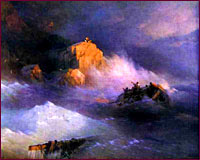 During
the period of 1840-1844 Aivazovsky, as a pensioner of the
Academy of Arts, spent time in Italy, traveled to Germany,
France, Spain, and Holland. He worked much and had many exhibitions,
meeting everywhere with success. He painted a lot of marine
landscapes, which became very popular in Italy: The Bay of
Naples by Moonlight (1842), Seashore. During
the period of 1840-1844 Aivazovsky, as a pensioner of the
Academy of Arts, spent time in Italy, traveled to Germany,
France, Spain, and Holland. He worked much and had many exhibitions,
meeting everywhere with success. He painted a lot of marine
landscapes, which became very popular in Italy: The Bay of
Naples by Moonlight (1842), Seashore.
In the course of his work, Aivazovsky evolved his own
method of depicting the motion of the sea – from memory,
without preliminary sketches, limiting himself to rough pencil
outlines.
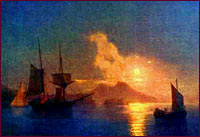 Aivazovsky’s
phenomenal memory and romantic imagination allowed him to
do all this with incomparable brilliance. The development
of this new method reflected the spirit of the age, when the
ever-increasing romantic tendencies put an artist's imagination
to the front. Aivazovsky’s
phenomenal memory and romantic imagination allowed him to
do all this with incomparable brilliance. The development
of this new method reflected the spirit of the age, when the
ever-increasing romantic tendencies put an artist's imagination
to the front.
Towards the 1850s the romantic features in Aivazovsky’s
work became increasingly pronounced. This can be seen quite
clearly in one of his best and most famous paintings The Tenth
Wave (1850) and also in Moonlit Night (1849), The Sea. Koktebel.
(1853), Storm (1854) and others.
|
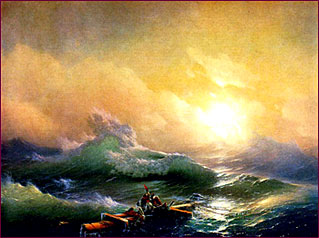
|
The process, which determined the development
of Russian art in the second half of the 19th century, also
affected Aivazovsky. A new and consistently realistic tendency
appeared in his work, although the romantic features still remained.
Aivazovsky left more than 6000 paintings, which are of very
different value. There are masterpieces and there are very timid
works. He failed to draw landscapes, could not draw a man.
Aivazovsky got good commissions and became rich. He spent
much money for charity, especially for his native town, he opened
in Feodosia the first School of Arts (in 1865), then the Art
Gallery (in 1889). He was a member of Academies of Stuttgart,
Florence, Rome and Amsterdam. |
|



